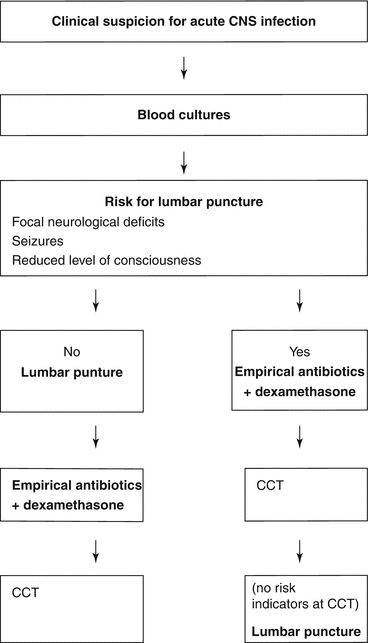Fig. 29.1
Masses of Gram-positive extracellular diplococci (Streptococcus pneumoniae) surrounded by activated leucocytes in the CSF
Latex agglutination-based rapid tests are available for major meningitis pathogens, but imperfect sensitivity and specificity argue against routine clinical use.
The CSF in bacterial meningitis is characterized by a strongly elevated white blood cell count (>500 cells/μl) with predominant neutrophils and a strongly elevated protein (>1 g/l), indicating severe blood-CSF barrier disruption. Increased lactate (>0.3 g/l) and decreased glucose CSF/blood ratio (<0.4) support the diagnosis of acute bacterial meningitis.
Lower cell counts and a mixed pleocytosis are observed with L. monocytogenes, M. tuberculosis and fungi; also, they may be found in partially or insufficiently treated meningitis. Peripheral white blood cells, serum C-reactive protein and procalcitonin are usually elevated in bacterial meningitis but are of limited diagnostic value in the emergency situation. The later parameters in normal ranges together with lower cell counts predominantly lymphocytotic in the CSF are suggestive for viral or fungal meningitis.
29.2.2 Computer Tomography of the Head (CCT)
A cranial CT provides information concerning intracranial complications such as brain oedema, hydrocephalus and infarcts. Moreover, bone window imaging identifies parameningeal foci such as sinusitis, mastoiditis or odontogenic abscess. Those patients who present with focal neurological deficits or seizures and those who have a disturbed consciousness should have a cranial CT before lumbar puncture. Of those patients without focal signs or seizures and with a normal level of consciousness, CT abnormalities are found in less than 3 % and CSF can be drawn without prior CT scanning. Under no circumstances the CCT should delay antibiotic treatment in highly suspicious cases. MRI scans in the acute setting are not recommended since no further information is gained (Fig. 29.2). In our patient, due to fluctuating qualitative impairment of his consciousness, a CCT scan revealed no pathologies and was performed only because the procedure did not delay treatment (<15 min).


Fig. 29.2
Decision tree in acute CNS infection
29.2.3 CSF Tests
The CSF was withdrawn and proved the diagnosis of pneumococcal meningitis (12 × 103 leucocytes/ml, 99 % neutrophils, CSF protein 1.3 g/l, lactate 0.8 g/l glucose CSF/blood ratio 0.2). In the CSF extracellular Gram-positive cocci were seen and qualified as pneumococci (Fig. 29.1). The CSF culture confirmed Streptococcus pneumoniae as suggested by Gram staining, 36 h later, as well as the blood culture results (Fig. 29.1). The MIC (minimal inhibitory concentration) was <0.1 μg/ml for penicillin. Together with systemically lowered leucocytes, fever of 38.8 C and a heart rate of 110 sepsis criteria are fulfilled.
29.3 Final Diagnosis
Pneumococcal meningitis with sepsis
29.4 Definition of Bacterial Meningitis
Bacterial meningitis is an inflammation of the meninges, in particular the arachnoid and the pia mater, associated with the invasion of bacteria into the subarachnoidal space. A hallmark of bacterial meningitis is the recruitment of highly activated leucocytes into the CSF. Besides bacteria, viruses, fungi and noninfectious causes as in systemic and neoplastic disease as well as certain drugs can induce meningeal inflammation.
Streptococcus pneumoniae and Neisseria meningitidis are the most common and most aggressive pathogens of meningitis. Symptomatic headache results from the activation of trigeminal C fibres in the meninges and is categorized as headache attributed to bacterial meningitis and meningoencephalitis (9.1.1, HIS 3rd edition, 2013).
Bacterial meningitis is a medical emergency requiring immediate diagnosis and immediate treatment.
29.5 Management and Treatment Options
Antibiotic treatment (cefotaxime 3 × 4 g i.v. and ampicillin 6 × 2 g i.v., Table 29.1) followed the administration of dexamethasone 10 mg i.v. (every 6 h/4 days) and the patient was transferred to our neurocritical care unit for one night. Once pneumococci were confirmed in the CSF culture, only cefotaxime was continued for 10 days.
Table 29.1
Empiric antibiotic therapy in adults in bacterial meningitis
Probable pathogens | Empirical therapy | |
|---|---|---|
Infants and children | N. meningitides | Cephalosporinb (+vancomycin or rifampicinc) |
S. pneumoniae | ||
S. agalactiae | ||
E. coli (H. influenzae a ) | ||
Adults | S. pneumoniae | Cephalosporinb + ampicillin (+vancomycin or rifampicinc) |
N. meningitidis | ||
L. monocytogenes d | ||
Aerobic streptococci (H. influenzae) | ||
Chemoprophylaxis of close contacts < div class='tao-gold-member'>
Only gold members can continue reading. Log In or Register to continue
Stay updated, free articles. Join our Telegram channel
Full access? Get Clinical Tree
 Get Clinical Tree app for offline access
Get Clinical Tree app for offline access

|